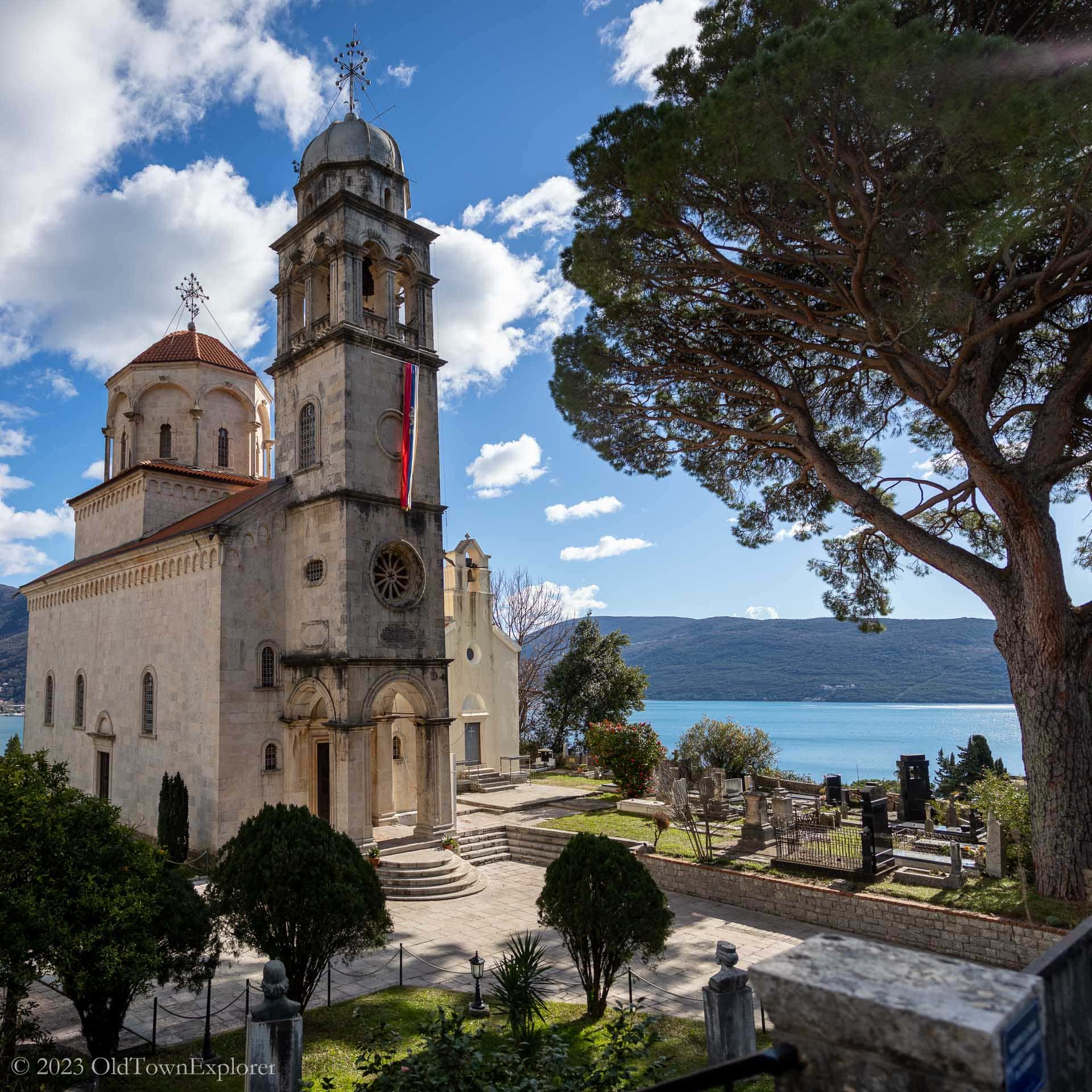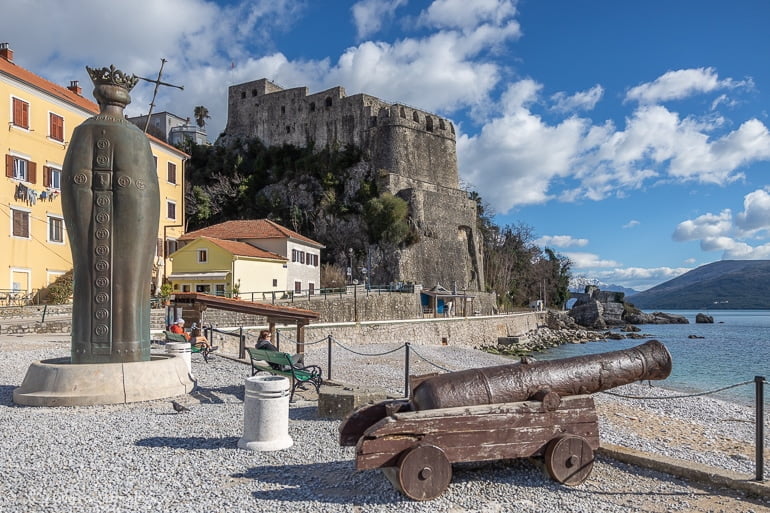Herceg Novi Architecture
Explore Herceg Novi Architecture: Churches, Palaces & More
Herceg Novi, perched at the entrance to the Bay of Kotor, reveals its layered history through a blend of Venetian, Ottoman, and Austro-Hungarian architecture. Known for its steep alleys, sea-facing fortresses, and diverse sacred buildings, the city’s architecture reflects centuries of shifting rule and cultural fusion.
Founded in 1382 by King Tvrtko I of Bosnia, Herceg Novi has passed through the hands of empires—Ottoman, Spanish, Venetian, Habsburg, and more—each leaving its mark on the cityscape. Today, you’ll find Orthodox and Catholic churches, medieval fortifications, and stone-paved squares that offer insight into the town’s dynamic past.
We spent a month in Herceg Novi walking its Old Town, visiting its forts, and tracing its architectural development from the 14th century to the present. This guide distills our research to help you explore Herceg Novi architecture with clarity and confidence.
This page contains affiliate links. We may earn a small commission at no extra cost to you.
Churches and Monasteries in Herceg Novi
Herceg Novi’s religious architecture spans centuries and denominations, from Baroque Catholic churches to medieval Orthodox monasteries. Many of these sacred sites were rebuilt or repurposed as political rule shifted between empires. Today, the churches and monasteries of Herceg Novi provide a tangible record of the town’s multicultural and spiritual heritage.

St. Archangel Michael Church
- Architect: Milan Karlovac
- Architectural Style: Byzantine, Gothic, Baroque
- Year Built: 1883–1911
- Address: Marka Vojnovića, Herceg Novi, Montenegro
Located in Belavista Square, the St. Archangel Michael Church was constructed during Austro-Hungarian rule using stone from Korčula. Its white marble iconostasis and eclectic architectural mix make it a striking centerpiece of the Old Town.

Church of St. Jerome
- Architect: Unknown
- Architectural Style: Baroque
- Year Built: 1856–1857
- Address: Trg Sv. Jeronima, Marka Cara, Herceg Novi
Built on the site of an older 17th-century Catholic church, this parish is known for its baroque paintings by Tripo Kokol. It remains an active place of worship in the heart of the lower Old Town.

Church of the Holy Savior (St. Spasa)
- Architect: Unknown
- Architectural Style: Orthodox
- Year Built: 1709–1713 (renovated 1864)
- Address: FG4G+8R3, Njegoševa, Herceg Novi
Adjacent to the Church of St. George, this Serbian Orthodox church was substantially renovated in the 19th century. Its interior houses donations from prominent historical figures.
Saint George Church
- Architect: Unknown
- Architectural Style: Orthodox
- Year Built: 17th century
- Address: FG4G+9QC, Njegoševa, Herceg Novi
A modest Orthodox church near the Church of the Holy Savior, reflective of the region’s long-standing Orthodox Christian tradition.

Church of St. Leopold Mandic
- Architect: Unknown
- Architectural Style: Catholic
- Year Built: 1688
- Address: Herceg Novi, Montenegro
Originally dedicated to St. Francis, this small Catholic church was built during Venetian rule. It is now named for St. Leopold Mandić, born in Herceg Novi and canonized in 1983.

Savina Monastery
- Architect: Various
- Architectural Style: Byzantine, Baroque
- Year Built: 11th–18th centuries
- Address: Eastern Herceg Novi
This Serbian Orthodox complex includes three churches and a monastery library. The Small Church of the Assumption (1030, renovated 1831) features frescoes by Lovro Dobricević. The Great Temple of the Assumption (1777–1799) was built by Nikola Foretić in Dalmatian Baroque style. The Church of St. Sava, attributed to the 13th century, lies further uphill. Relics and medieval manuscripts are preserved on-site.
Forts in Herceg Novi
Strategically located at the mouth of the Bay of Kotor, Herceg Novi has long been a site of military significance. Its fortresses, towers, and citadel reflect centuries of defensive construction by various empires—including the Ottomans, Venetians, and Austro-Hungarians. Today, these historic structures offer panoramic views, atmospheric ruins, and insight into the city’s layered past.

Forte Mare
- Architect: Unknown
- Architectural Style: Mixed (Medieval, Ottoman, Venetian)
- Year Built: 14th century onward
- Address: Coastal Old Town, Herceg Novi
Built by Tvrtko I in the 14th century, Forte Mare (“Sea Fortress”) was expanded under Ottoman and Venetian control. Its current layout dates to Turkish modifications in the 16th century. The fortress is perched above the sea and serves as a summer venue for festivals and performances.

Kanli Kula Fortress
- Architect: Unknown
- Architectural Style: Ottoman
- Year Built: First recorded in the 17th century
- Address: North Old Town, Herceg Novi
Kanli Kula (“Bloody Tower”) stands 85 meters above sea level. Initially an Ottoman prison and watchtower, it was modified under Austro-Hungarian rule and after the 1979 earthquake. Today, it contains one of the Adriatic’s largest open-air amphitheaters.

Fortress Spanjola
- Architect: Unknown
- Architectural Style: Mixed (Spanish-Ottoman)
- Year Built: 1538–1548
- Address: Sbrina Street, Upper Herceg Novi
Begun by the Spanish during their brief rule and completed by the Ottomans, Spanjola (or Gorni Grad) is an abandoned fortress with scenic views. Though unrestored, it remains accessible by foot or car and features remnants of defensive tunnels connecting upper and lower town.

Citadel
- Architect: Unknown
- Architectural Style: Ottoman-Venetian
- Year Built: Unknown
- Address: Coastal ruins, Herceg Novi
Now partially submerged due to coastal erosion, the ruins of the Citadel once formed a key part of the city’s maritime defenses. Only fragments remain, visible near the shore.

Western Tower
Zapadna Kula
- Architect: Unknown
- Architectural Style: Ottoman
- Year Built: Unknown
- Address: Near Market Square, Old Town
The Western Tower is the last surviving section of the Ottoman-era city walls dismantled by the Austrians. It sits left of the Clock Tower when viewed from the main gate.
Other Attractions in Herceg Novi
Beyond its churches and fortresses, Herceg Novi is filled with architectural elements that reveal how public life unfolded across centuries of urban transformation. From Ottoman towers to Austro-Hungarian promenades, these civic and cultural landmarks anchor the city’s historic identity and offer moments of everyday beauty.

Nikola Đurković Square
- Architect: Unknown
- Architectural Style: Urban civic square
- Year Built: Founded 1382
- Address: Central Old Town
The city’s main square since its founding, Nikola Đurković Square remains a central gathering place. It marks the entrance to the Old Town and is surrounded by several key landmarks.

Clock Tower
Sahat Kula / Tora
- Architect: Unknown
- Architectural Style: Ottoman military architecture
- Year Built: 1667 (estimated)
- Address: Nikola Đurković Square, Herceg Novi
Built under Ottoman rule, the Clock Tower once served as a gate tower, watchtower, and call to prayer. It is now a symbol of Herceg Novi and stands at the entrance to the Old Town.

Stairs of King Tvrtko
- Architect: Unknown
- Architectural Style: Functional stone staircase
- Year Built: Unknown
- Address: Connects Nikola Đurković Square and Belavista Square
This historic stairway links the lower and upper sections of the Old Town and passes directly beneath the Clock Tower.

Belavista Square
Trg Herceg Stejpana
- Architect: Unknown
- Architectural Style: Mixed urban square
- Year Built: Various periods
- Address: Trg Herceg Stejpana, Herceg Novi
Locally known as Belavista, this upper Old Town square is home to the Church of St. Archangel Michael and features a mix of Austro-Hungarian and Mediterranean facades.
Trg Mića Pavlovića
- Architect: Unknown
- Architectural Style: Layered religious site
- Year Built: Various periods
- Address: Lower Old Town, Herceg Novi
Once home to a mosque, and before that a Catholic church, this square now hosts the Church of St. Jerome. Its religious layering reflects the city’s shifting political and cultural influences.

Pet Danica Promenade
- Architect: Unknown
- Architectural Style: 20th-century waterfront promenade
- Year Built: 1970s
- Address: Bay of Kotor waterfront
Built on the former Austro-Hungarian railway bed, this 7-kilometer promenade links the Old Town to the bay’s edge. It’s a lively corridor for walking, dining, and coastal views.

Škver City Harbor
- Architect: Unknown
- Architectural Style: Maritime-industrial repurposing
- Year Built: 20th century
- Address: Waterfront, Herceg Novi
This former railway hub is now a lively harbor with a cafe, gallery, and pool. Its lighthouse and pier are active with small boats and locals.

Monument to King Tvrtko I of Bosnia
- Sculptors: Dragoljub and Miodrag Dimitrijević
- Material: Bronze
- Year Built: 2013
- Address: Near Forte Mare, Herceg Novi promenade
This modern monument honors the city’s founder and was placed beside the sea where his fortress once stood. It symbolizes Herceg Novi’s enduring link to Bosnian royal heritage.
Things to Know About Herceg Novi Architecture
A Confluence of Styles
Herceg Novi’s architecture is shaped by centuries of shifting control between empires. The city showcases a layered mix of Ottoman fortresses, Venetian towers, Austro-Hungarian civic buildings, and Orthodox and Catholic churches. This diversity creates a distinct urban identity where East meets West on the Adriatic coast.
Materials and Methods
Limestone from nearby Korčula was commonly used in churches and fortresses. Decorative features like rosettes, belfries, and iconostases reflect regional craftsmanship from Dalmatia and Kotor. Fortifications such as Forte Mare and Kanli Kula evolved over time as new military techniques were introduced under different regimes.
Preservation and Access
Many architectural landmarks—such as Forte Mare and Savina Monastery—are well-maintained and open to visitors. Others, like Fortress Spanjola, are abandoned but accessible, offering unregulated exploration and striking views over the Bay of Kotor.
Religion and Architecture
Religious buildings in Herceg Novi often sit on reused sites. Churches have been built, demolished, and reconstructed depending on the faith of the ruling power. This repetition of sacred use contributes to the dense layering of architectural history in the Old Town.
Best Places to Stay in Herceg Novi
Hotels in Herceg Novi
For travelers interested in architecture, staying in or near the Old Town offers the most immersive experience. The area around Belavista Square and Nikola Đurković Square places you within walking distance of historic churches, fortresses, and staircases—all in view of the Bay of Kotor.
Accommodations near the Pet Danica Promenade also provide easy access to coastal landmarks like Forte Mare, Škver Harbor, and the King Tvrtko I monument. These areas blend history with sea views, offering a practical and scenic base for exploring Herceg Novi’s architectural sites.
Use the interactive map below to find hotels and apartments that match your travel dates and preferences.
FAQs About Herceg Novi Architecture
What is the architecture of Herceg Novi like?
Herceg Novi’s architecture blends elements from the Ottoman, Venetian, and Austro-Hungarian empires. The city is known for its sea-facing fortresses, religious buildings, and layered urban layout with steep alleys and staircases.
What are the main architectural landmarks in Herceg Novi?
Key landmarks include Forte Mare, Kanli Kula, the Savina Monastery complex, the Clock Tower, and Belavista Square. Each reflects different periods of the city’s political and religious history.
Can you visit the fortresses and churches in Herceg Novi?
Yes, many historic sites are accessible to visitors. Forte Mare and Kanli Kula often host cultural events. Churches like St. Archangel Michael and the Great Temple of the Assumption are active places of worship but open to respectful visitors.
How old are the buildings in Herceg Novi?
Some structures date back to the 14th century, such as parts of Forte Mare and the Savina Monastery. Other landmarks were built or renovated during the 17th to 19th centuries under various imperial powers.
Is there a recommended walking route to see the architecture?
Yes. Start at Škver Harbor and walk along the Pet Danica Promenade to Forte Mare. Climb through the Old Town via the Stairs of King Tvrtko to reach the Clock Tower, Belavista Square, and Savina Monastery. Allow time for detours to Kanli Kula and Fortress Spanjola.
Herceg Novi is more than a coastal resort—it’s a city layered with architectural evidence of conquest, faith, and cultural exchange. From weathered fortresses to frescoed monasteries, its streets invite exploration and reflection. Whether you’re drawn by panoramic views, intricate iconostases, or the echoes of empire, Herceg Novi offers an architectural journey that rewards every step.
